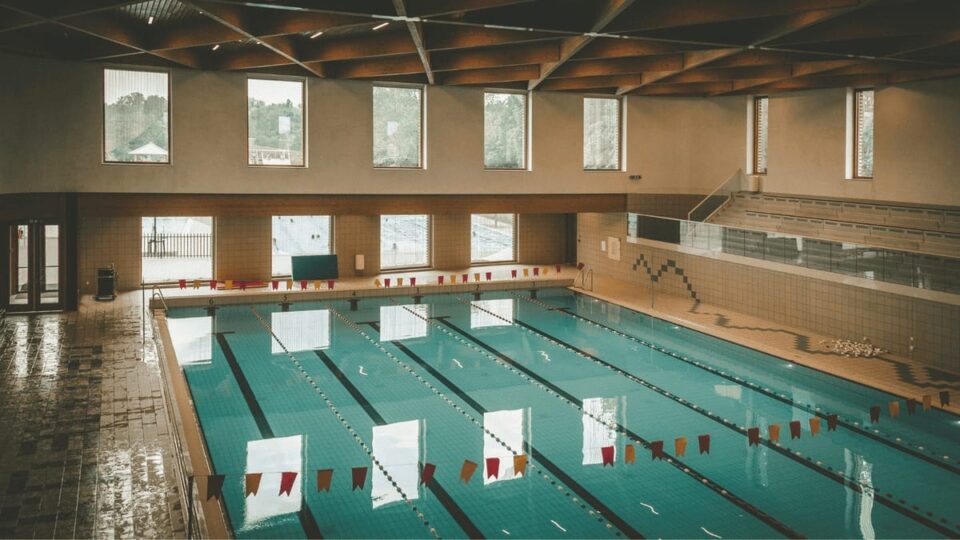40-50% relative humidity is generally considered the optimal humidity level for any indoor facility. If relative humidity is too high it can cause dampness and deterioration of the building’s infrastructure, so a robust ventilation strategy is needed to manage humidity and keep it within the optimal zone.
Keep reading to learn more about indoor swimming pool ventilation requirements, including the industry requirements and the top recommended ventilation solutions.
What happens without proper indoor swimming pool ventilation?
To help you understand how crucial ventilation is to the safe management of indoor swimming pools, let’s explore the consequences of high humidity levels. Here’s what happens without proper indoor swimming pool ventilation:
- Poor health – You must use chemicals like chlorine to keep a pool clean. Chlorine can be extremely harmful when inhaled in large quantities, causing eye irritation and breathing difficulties. Ventilation removes chlorine and other cleaning agents from the air.
- Discomfort – if it is too humid in a swimming pool facility, occupants will overheat and become uncomfortable. The thick smell of pool chemicals will enhance their discomfort.
- Mouldy and musty odours – when moisture accumulates within any indoor facility, it becomes the perfect environment for mould growth. Dampness and mould can lead to musty and unpleasant odours and harm occupants’ lung health.
- Condensation – when the humidity in the air touches a cold surface, such as a wall or window, it will condense. This will lead to the accumulation of moisture, which presents slipping hazards and can deteriorate the structural integrity of the building.
- Corrosion – another harmful consequence of moisture buildup is the potential for rust and corrosion. Oxygen and moisture together can quickly deteriorate any metal fixtures in your facility and will require more frequent replacement.
- Higher operating costs – without proper ventilation, it will be more difficult to manage the temperature in your facility, and any air conditioning units will be working overtime to provide a cool atmosphere. This will increase your operating costs and interfere with your profit margins.
How does ventilation help manage humidity and contaminants in indoor swimming pools?
Now that you know the issues associated with improper ventilation in swimming pools, let’s discuss the advantages of investing in ventilation solutions for your indoor swimming pool.
Controlling temperature and humidity
Ventilation solutions help to control temperature levels within a pool facility through destratification. Stratification is a process that occurs when heat rises and cold air sinks, leading to uneven temperature distribution. Destratification uses air circulation to mix the hot and cold air and provide even temperature distribution.
This air circulation can also help to reduce stagnant air pockets in the facility that can become host to humid air and moisture. If you invest in an extraction or exhaust ventilation solution, the moisture in the air will be removed and exhausted to the building’s exterior to provide more comfortable conditions within the facility.
Preventing condensation
By providing extraction for moisture in the air, ventilation solutions help to reduce condensation. Condensation increases moisture levels on the leisure facility’s floors, walls, and ceilings, causing structural damage and increasing the risk of slips and injuries. Ventilation is the ideal solution to reduce condensation and make the facility safer.
Extracting fumes
Ventilation solutions extract harmful chemicals and salt-laden air in a swimming pool facility. Extracting fumes using a Hooded Base Roof Fan or Exhaust Fan will ensure occupants can breathe properly and reduce the chance of eye irritation.
Top ventilation solutions for indoor swimming pools
Let’s discuss the top recommended solutions for ventilation in indoor swimming pools.
- Giant Fans – a Giant Fan is the top solution for air destratification. It provides high-volume airflow perfect for large swimming facilities. It creates a vertical airflow to draw air upwards and ensure proper air circulation.

- Direct Drive Axial Fan – a Direct Drive Axial Fan removes contaminated air and air dispersion to regulate both temperature and pollutants. Heat, steam, dust, and other emissions can be managed easily with an Axial Fan.

- Side Wall Exhaust Fan – a Side Wall Exhaust Fan extracts heat, dust, and fumes while encouraging a steady airflow exchange rate.

- Profile Base Hooded Roof Fan – this fan is fitted on your roof structure, providing extraction for contaminated air while supplying fresh, cool air to increase comfort.

Choose Fanquip for planning your swimming pool ventilation strategy.
Ventilation makes the management of a swimming pool easier. It increases the longevity of the building’s structure by reducing dampness, mould, mildew, and rust, and also increases safety by preventing slips and falls and ensuring clean and uncontaminated air.
You’ll benefit from expert advice if you’re planning your swimming pool ventilation strategy. The Fanquip team can help you meet the optimal airflow exchange rates and improve air quality with the top ventilation solutions.
